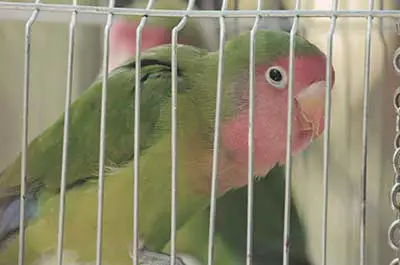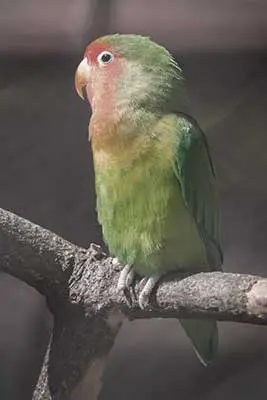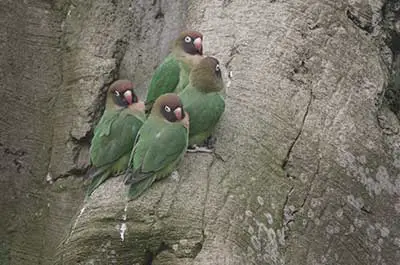Anyone who has ever loved a lovebird can attest to its unique, charming nature. These little birds are relentless in their desire to please and make you happy, but they also require a lot of care. If you’re thinking of adding a lovebird to your family, be sure to read up on the basics of lovebird care first! This will help ensure that your new pet is healthy and happy. We’ll discuss some tips for keeping your lovebirds healthy and content in this post. Thanks for reading!
Lovebirds need a clean and spacious cage.
Your lovebird’s cage should be big enough for your lovebird to flap his wings freely. A good rule of thumb is that your lovebird’s cage should be at least two times the size of your lovebird when it is fully grown. Your lovebird’s cage should also have horizontal bars, as lovebirds like to climb.

You can buy a ready-made lovebird cage or build your lovebird cage.
If you buy a ready-made lovebird cage, make sure it is easy to clean.
If you’re DIY-ing your lovebird’s cage, be sure to keep the following tips in mind:
- The spacing between bars should be wide enough so your lovebird can’t squeeze through.
- The cage floor should be covered with a material that’s easy to clean, like newspaper or paper towels.
- The cage should be placed in a well-lit area with fresh air (but not in direct sunlight).
- The minimum size for a pair of lovebirds is 18″ by 18″, but bigger is always better – a minimum of 36″ by 24″ or 30″ by 24″ is recommended. If you have more than one lovebird, a larger cage is essential to ensure they all have enough room. If you want to keep your lovebird in a bigger cage, it should be at least 24″ by 30″ for one pair and larger for multiple pairs.
Make Sure Your Lovebirds Get Enough Attention.
Lovebirds are social animals, and as such, they require a lot of attention from you and the rest of your family. They also need regular socialization with other lovebirds, so if you plan to keep your bird in a single cage by itself, this might not be the best choice of pet for you.
Lovebirds live in the wild in flocks of up to 50, and although they love to be with you, their social nature requires them to be in a group of at least three. For this reason, you should never keep your lovebird alone – they need the companionship of another lovebird or a pair of lovebirds.
However, if your entire family is very active and you have another lovebird to keep your new one company, that’s a different matter.
Lovebirds are pretty noisy, so if you don’t have the time to spend with your lovebirds, you should consider getting a different pet.
Lovebirds need a variety of perches and toys.
Lovebirds burn a lot of energy every day, and they need to get a good workout. That’s why it’s crucial to provide your lovebird with a variety of perches.
You should provide your lovebird with the following types of perches:
- Natural branches
- Wooden dowels
- Coconut coir
- Scaffold boards
- Vertical bars & ladders
The size of the perch you should provide depends on your lovebird’s size. For small to medium lovebirds, 1/8″ dowels are the best option for perches. Larger birds can handle 5/8″ dowels, and extra-large lovebirds (lovebirds whose wingspan is 2 and a half feet or more) should have 1″ dowels.
It’s also important to vary the texture of your bird’s perches. It needs both rough and smooth perches to wear down its nails and keep them at the right length.
Toys are also essential for your lovebird to keep them active and entertained. You can buy ready-made toys or make your own using these toy-making tips:
- The size of the toy should be proportional to your lovebird’s size.
- Toys with bells are great because your lovebird will enjoy making noise with them.
- Toys should be rearranged often, so your bird doesn’t get bored.
Your lovebird’s cage should also have lots of things for your bird to chew on. Remember that lovebirds are very creative and intelligent birds, so they need a variety of toys and things to chew on.
Lovebirds need a diet that is high in protein and low in sugar.

It’s important to understand that the health of your lovebird will depend on its diet. A bird with a healthy diet is more likely to be active and chatter a lot, both signs of a happy bird.
Did you know that 70% of your lovebird’s diet should be plant-based? A diet primarily made up of fruit and vegetables is excellent for your lovebird, but it also needs to be supplemented with healthy proteins.
Some of the best sources of protein for your lovebird are
- Cooked beans
- Hard-boiled eggs
- Other cooked legumes
- Cooked meat & fish
- Nuts
Yeast extract spread, barley grass powder, or spirulina powder are great sources of chlorophyll, which will improve your bird’s digestion.
It is also vital to give your lovebird a source of calcium every day.
The best ways to do this are
- Line the bottom of your lovebird’s cage with cuttlebone
- Spray your lovebird’s food with a calcium supplement
- Grind up eggshells and sprinkle them into your lovebird’s food dish
Lovebirds need to eat small portions of healthy snacks throughout the day. If you don’t give your lovebird food to eat throughout the day, it will start eating your other bird’s food or its droppings.
Make sure your lovebird has a bath every day.
Your lovebird will benefit from a daily bath. It’s ideal for letting your lovebird bathe in a shallow bowl for half an hour every morning, but if that’s not possible, you should at least allow your lovebird to take a bath in its drinking water.
Lovebirds need to take daily baths to keep their feathers healthy. You can do this by filling a bowl with lukewarm (or cool, if your lovebird is not used to warm water) water and misting its feathers every day.
Your lovebird needs to go outside every day.
Lovebirds are very active birds, and they need to move their muscles every day. That’s why daily exercise is necessary for your lovebird’s health and happiness. The best way for your lovebird to exercise is by going outside into a small room or covered patio.
Lovebirds are very active, and they must get out of their cage to stretch their wings every day. The best way to do this is to attach a large play top cage to your lovebird’s cage and let it go inside that cage every day.
If you don’t have a play top, put your lovebird on top of its cage for a few minutes every day.
Lovebirds need lots of fresh air and sunshine, so keeping their cage away from direct sunlight is important.
Never punish your lovebird for biting you!

Lovebirds are very intelligent, and they will keep trying to bite you until you learn what they want. If your lovebird is biting you, wait for it to preen or stretch. Once its beak is free, it will most likely bow its head and close its eyes in a way that means “I’m sorry.”
If your lovebird bites you when you’re petting it, stop moving your hand and wait for its head to bow. Your lovebird will most likely try to nuzzle your hand and preen it after it bows.
Lovebirds need lots of attention from you, so don’t ever stop touching them! They get mad when they’re not getting the kind of touch they like.
Remember that every bird is different, and you will need to learn your own bird’s preferences.
Lovebirds need plenty of fresh water and should not be given fruit juice.
Water is essential for your lovebird’s health, but too much fruit juice can dehydrate your bird. Give your lovebird fresh water every day, and make sure your lovebird always has a bowl of clean water to drink from.
Lovebirds can eat many fruits and vegetables, but they can’t drink fruit juice. Make sure your lovebird is drinking enough water every day. If it isn’t, its droppings will become small and dry.
Regularly trim their nails to avoid overgrown talons.
Your lovebird’s nails should be shorter than the length of its foot. Nails grow quickly, so you should cut them every week. If your lovebird’s nails start to curl under its toes, it’s time to cut them.
There are two main ways to keep your lovebird’s nails trimmed. You can use a pair of nail clippers, or you can file your lovebird’s nails. To trim your lovebird’s nails with clippers, take a small portion of one nail at a time and clip it off. Repeat this process for each nail, and then file the nails with a small emery board or nail file.
If you don’t trim your lovebird’s nails, they will get long and curl. This makes it harder for your lovebird to perch and grasp things with its feet.
Always keep your lovebird away from drafts.
Lovebirds are very sensitive to drafts, so you should always keep them away from windows and doors with strong gusts of wind.
Make sure your lovebird’s cage is never placed near an open window because it could get cold. When you’re setting up its cage, keep it away from any open doors or other drafts.
Lovebirds are very cold-sensitive, so you should always place their cage in a warm area of the house.
Always put your lovebird to bed at night with food and water inside its cage. Your lovebird might try to fly away at night, so it’s important to put its food and water inside the cage every night. Don’t ever let your lovebird roam your home at night because it could get lost or eaten by a cat!
Conclusion.
Your lovebird should have a long and healthy life if you follow these instructions. I hope this article was helpful to all who have lovebirds as a pet.
And as always, I wish you all the best with your pets!

Meet Marcella Raskin: Founder, Editor-in-Chief, and a Maven in Human Potential
Dive into the rich tapestry of Marcella Raskin’s life and you’ll discover more than just an editor-in-chief. At the core, Marcella is a passionate writer, deeply committed to unlocking the boundless human potential. Armed with expertise in Cognitive Behavioral Therapy, Life Purpose Coaching, and Group Life Coaching, she’s carved a niche in helping both women and men unearth their true selves through the art of writing. Every article she pens is a gateway, inviting readers to shift mindsets and embrace transformation, even when change seems impossible.
Beyond her literary pursuits, Marcella is a fitness enthusiast, underpinned by her background in Exercise Physiology. And when she’s not empowering others or delving into the science of movement, she’s reveling in the joys of motherhood, raising two incredible girls, and sharing life’s moments with her beloved spouse.
Trust Marcella’s words; they’re backed by expertise, passion, and a journey full of learning and growth.
Reviewed By: Joanna Perez and Brenda Tillman
Edited By: Lenny Terra
Fact Checked By: Matthew Mansour
Photos Taken or Curated By: Matthew Mansour